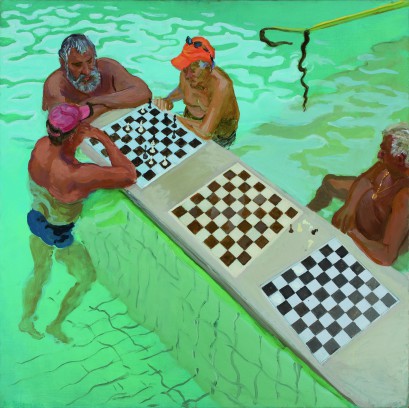More than 40 paintings by contemporary Hungarian painters will be displayed at an exhibition in the Royal Łazienki. The works alluding to the phenomenon of the Hungarian bathing culture come from the Völgyi-Skonda Contemporary Art Collection and are presented as part of the Year of Hungarian Culture in Poland.
The exhibition "Kraj łaźni, kultura kąpieli" (Bath Country, Bathing Culture), organized by the Hungarian Cultural Institute and the Royal Łazienki Museum, will be open from 26 October to 17 December 2017: on Mondays, between 10.00 and 14.00, and from Tuesday to Sunday, between 10.00 and 16.00. Admission is free.
The exhibition will feature paintings by contemporary Hungarian artists, who decided to devote their works to the everyday life in the baths of Budapest. Visitors will have a chance to see works by such painters as: Pál Breznay, Péter Hecker, Rita Mártis and Eszter Radák, Márta Kiss, as well as Tamás Galambos.
The majority of the works have been commissioned, which demonstrates that the theme of bathing – although rarely used – turned out to be a fascinating challenge for the artists.
Paintings by Pál Breznay "Rummy" and "Chess II", which will be presented at the exhibition, depict the rituals of the Saint Luke and Széchenyi baths in Budapest – a game of chess in the water, and a card game at the table. The depicted persons are authentic, and so is the figure of Ferenc – former chauffeur of the communist leader of Hungary, János Kádár – appearing in the painting, "Ferenc from the Lukács Bath". He is widely known at the bath and it is no secret that in exchange for beer, he will gladly tell an anecdote about comrade Kádár.
Scenes from the painting by Péter Hecker, "Dad Playing as a Train in Warm Water", depict fun at the swimming pool. Among other paintings showing contemporary times are works by Eszter Radák – evidently, the scene of water aerobics does not come from the 19th century, although the architectural details would indicate that the work in fact shows scenes from that period.
The painting by Márta Kiss, 'In the Bathhouse", depicting women whispering and a man clearly interested in their conversation, undoubtedly alludes to the biblical theme of Susanna and the Elders. On the one hand, it demonstrates that some situations are universal and timeless, but on the other hand, it shows a shift in proportions in favour of women, and a change of roles.
Tamás Galambos illustrates a bath from another perspective. His paintings, "Big Grub" and "Spoiling" are a satire on "gentlemen" drinking beer, eating sausages without moderation, and flirting. In another caricature, "Jacuzzi", painter Viktor Benkő presents people from the modern times, relaxing during a well-deserved bath.

The Art of Thinking Well. The Legacy of Stanisław Herakliusz Lubomirski
Palace on the Isle, Officer Cadets School Read full entry
